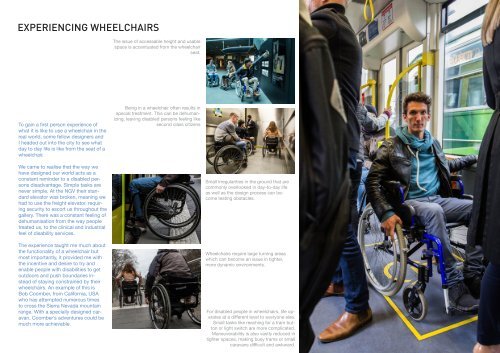Intrepid - Designing for Ability
Industrial Design
Industrial Design
You also want an ePaper? Increase the reach of your titles
YUMPU automatically turns print PDFs into web optimized ePapers that Google loves.
EXPERIENCING WHEELCHAIRS<br />
The issue of accessable height and usable<br />
space is accentuated from the wheelchair<br />
seat.<br />
To gain a first person experience of<br />
what it is like to use a wheelchair in the<br />
real world, some fellow designers and<br />
I headed out into the city to see what<br />
day to day life is like from the seat of a<br />
wheelchair.<br />
Being in a wheelchair often results in<br />
special treatment. This can be dehumanizing,<br />
leaving disabled persons feeling like<br />
second class citizens<br />
We came to realise that the way we<br />
have designed our world acts as a<br />
constant reminder to a disabled persons<br />
disadvantage. Simple tasks are<br />
never simple. At the NGV their standard<br />
elevator was broken, meaning we<br />
had to use the freight elevator, requiring<br />
security to escort us throughout the<br />
gallery. There was a constant feeling of<br />
dehumanisation from the way people<br />
treated us, to the clinical and industrial<br />
feel of disability services.<br />
The experience taught me much about<br />
the functionality of a wheelchair but<br />
most importantly, it provided me with<br />
the incentive and desire to try and<br />
enable people with disabilities to get<br />
outdoors and push boundaries instead<br />
of staying constrained by their<br />
wheelchairs. An example of this is<br />
Bob Coomber, from Cali<strong>for</strong>nia, USA<br />
who has attempted numerous times<br />
to cross the Sierra Nevada mountain<br />
range. With a specially designed caravan,<br />
Coomber’s adventures could be<br />
much more achievable.<br />
Small irregularities in the ground that are<br />
commonly overlooked in day-to-day life<br />
as well as the design process can become<br />
testing obstacles.<br />
Wheelchairs require large turning areas<br />
which can become an issue in tighter,<br />
more dynamic environments.<br />
For disabled people in wheelchairs, life operates<br />
at a different level to everyone else.<br />
Small tasks like reaching <strong>for</strong> a tram button<br />
or light switch are more complicated.<br />
Maneuverability is also vastly reduced in<br />
tighter spaces, making busy trams or small<br />
caravans difficult and awkward.


